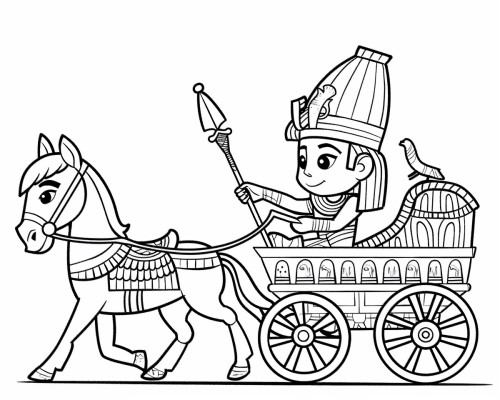NEXT 10 >
Printable Coloring Pages
Ancient Egypt Coloring Pages
Welcome to our captivating collection of Ancient Egypt printable coloring pages! Embark on an enthralling journey through the sands of time as your little ones explore the wonders of one of history's most fascinating civilizations. Coloring is not only an enjoyable and creative activity but also offers numerous benefits for a child's development, including improving hand-eye coordination, fine motor skills, focus, and relaxation.
Our Ancient Egypt coloring pages provide an engaging way for children to learn about this remarkable civilization, its history, and culture. From the majestic pyramids and the enigmatic Sphinx to the mysterious pharaohs and their elaborate tombs, these coloring pages will ignite curiosity and a love for history in young minds. As kids color these pages, they'll encounter the world of hieroglyphics, gods and goddesses, and ancient rituals, providing a unique opportunity to delve into the past while nurturing their artistic talents.
NEXT 10 >
Fun Facts About Ancient Egypt
- The Great Pyramid of Giza: The Great Pyramid of Giza, built for Pharaoh Khufu around 2580-2560 BCE, is the oldest and largest of the three pyramids in the Giza complex. It was the tallest man-made structure in the world for nearly 3,800 years and is the only one of the Seven Wonders of the Ancient World that remains largely intact today. The pyramid was constructed using more than 2.3 million limestone and granite blocks, each weighing between 2.5 and 15 tons.
- Ancient Egyptian makeup: Makeup played a significant role in the daily lives of both men and women in Ancient Egypt. They used cosmetics not only for aesthetic purposes but also for protection against the harsh sun and to ward off infections. The Egyptians used a green pigment called malachite for eye makeup and a black powder called kohl, made from ground-up minerals, to line their eyes. The elaborate eye makeup also held spiritual significance, as it was believed to protect the wearer from the evil eye.
- The invention of the calendar: The Ancient Egyptians were among the first to develop a calendar system. They used a solar calendar consisting of 12 months, each with 30 days, and added an additional five days at the end of the year to account for the Earth's 365-day orbit around the Sun. This calendar helped them keep track of important events, such as religious ceremonies and agricultural cycles.
- Egyptian board games: Ancient Egyptians enjoyed playing board games in their leisure time, with one of the most popular games being "Senet." Senet dates back to around 3100 BCE and is one of the world's oldest known board games. The game involved moving pieces on a board with 30 squares arranged in 3 rows of 10. Although the exact rules have been lost over time, Senet is believed to have had both strategic and religious significance.
- The Nile River: The Nile River, which stretches over 6,650 kilometers (4,130 miles), played a crucial role in the development of Ancient Egyptian civilization. It provided a reliable source of water, fertile soil, and transportation, enabling the growth of agriculture and the flourishing of the civilization. The Nile's annual flooding deposited nutrient-rich silt on the surrounding land, making it ideal for farming. The river also served as a primary trade route, connecting Egypt with the Mediterranean world and facilitating cultural exchanges.
 Egyptian gods and goddesses coloring pages
Egyptian gods and goddesses coloring pages
 Pharoah Ahkenaten
Pharoah Ahkenaten Pharoah Ramses the Great
Pharoah Ramses the Great Queen Cleopatra
Queen Cleopatra  Queen Nefertiti
Queen Nefertiti













